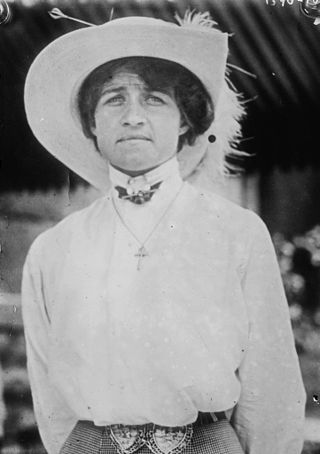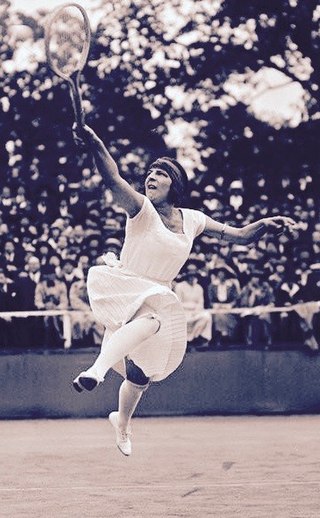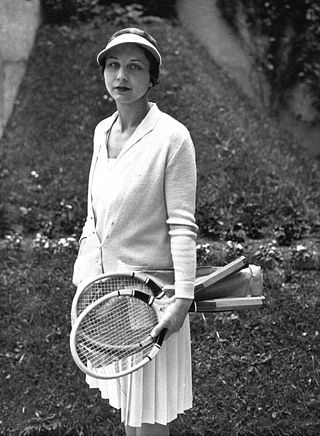
Charlotte "Chattie" Cooper Sterry was an English female tennis player who won five singles titles at the Wimbledon Championships and in 1900 became Olympic champion. In winning in Paris on 11 July 1900, she became the first female Olympic tennis champion as well as the first individual female Olympic champion.

May Godfrey Sutton was an American tennis player who was active during the first decades of the 20th century. At age 16 she won the singles title at the U.S. National Championships and in 1905 she became the first American player to win the singles title at Wimbledon.

Suzanne Rachel Flore Lenglen was a French tennis player. She was the inaugural world No. 1 from 1921 to 1926, winning eight Grand Slam titles in singles and twenty-one in total. She was also a four-time World Hard Court Champion in singles, and ten times in total. Lenglen won six Wimbledon singles titles, including five in a row from 1919 to 1923, and was the champion in singles, doubles, and mixed doubles at the first two open French Championships in 1925 and 1926. In doubles, she was undefeated with her usual partner Elizabeth Ryan, highlighted by another six titles at Wimbledon. Lenglen was the first leading amateur to turn professional. She ranked as the greatest women's tennis player from the amateur era in the 100 Greatest of All Time series on the Tennis Channel in 2012.

Helen Newington Wills, also known by her married names Helen Wills Moody and Helen Wills Roark, was an American tennis player. She won 31 Grand Slam tournament titles during her career, including 19 singles titles.

Hazel Virginia Hotchkiss Wightman, CBE was an American tennis player and founder of the Wightman Cup, an annual team competition for British and American women. She dominated American women's tennis before World War I and won 45 U.S. titles during her life.

Kathleen "Kitty" McKane Godfree was a British tennis and badminton player and the second most decorated female British Olympian, joint with Katherine Grainger.

Elizabeth Montague "Bunny" Ryan was an American tennis player who was born in Anaheim, California, but lived most of her adult life in the United Kingdom. Ryan won 26 Grand Slam titles, 19 in women's doubles and mixed doubles at Wimbledon, an all-time record for those two events. Twelve of her Wimbledon titles were in women's doubles and seven were in mixed doubles. Ryan also won four women's doubles titles at the French Championships, as well as one women's doubles title and two mixed-doubles titles at the U.S. Championships. During a 19-year run Ryan amassed a total of 659 titles in singles, doubles and mixed doubles.

Evelyn Lucy Colyer was a female tennis player from Great Britain. With Joan Austin, sister of Bunny Austin, Colyer played doubles in the 1923 Wimbledon final against Suzanne Lenglen and Elizabeth Ryan. Colyer and Austin were known in the British press as "The Babes." At the 1924 Paris Olympics, she teamed with Dorothy Shepherd-Barron to win a bronze medal in the women's doubles event.

The women's singles (outdoor) was one of six lawn tennis events on the Tennis at the 1908 Summer Olympics programme. The number of withdrawals resulted in empty brackets, with one player making it to the final without playing a single match while another had to win two to advance to that point. Nations could enter up to 12 players. In all, 13 women from 4 nations were entered but only 5 from Great Britain competed. The tournament was held from 7 to 11 July at the All England Lawn Tennis and Croquet Club. It was won by Dorothea Douglass Lambert Chambers, with Dora Boothby taking silver and Ruth Winch bronze.

Penelope Dora Harvey Boothby was an English tennis and badminton player. She was born in Finchley, Middlesex. She is best remembered for her ladies' singles title at the 1909 Wimbledon Championships. In Badminton, she won the 1909 All England Championships in Mixed doubles category.
The 1919 Wimbledon Championships took place on the outdoor grass courts at the All England Lawn Tennis and Croquet Club in Wimbledon, London, United Kingdom. The tournament ran from 23 June until 7 July. It was the 39th staging of the Wimbledon Championships, and the first Grand Slam tennis event of 1919. It was the first Wimbledon championship after a four-year hiatus due to World War I.
The 1920 Wimbledon Championships took place on the outdoor grass courts at the All England Lawn Tennis and Croquet Club in Wimbledon, London, United Kingdom. The tournament ran from 21 June until 3 July. It was the 40th staging of the Wimbledon Championships, and the second Grand Slam tennis event of 1920.

The women's singles was a tennis event held as part of the Tennis at the 1920 Summer Olympics programme. A total of 18 players from 7 nations competed in the event, which was held from 16 to 24 August 1920 at the Beerschot Tennis Club. The event was won by Suzanne Lenglen of France, defeating Dorothy Holman of Great Britain in the final. It was the second consecutive victory for a French woman, with Marguerite Broquedis winning the pre-war 1912 tournament. Kathleen McKane Godfree of Great Britain defeated Sigrid Fick of Sweden in the bronze-medal match.

Ethel Larcombe was a British female tennis player and badminton player. She won the ladies' singles tennis title at the 1912 Wimbledon Championships as well as 11 badminton titles at the All England Badminton Championships.
Dorothea Lambert Chambers defeated Edith Johnson 6–4, 6–2 in the All Comers' Final, and then defeated the reigning champion Dora Boothby 6–2, 6–2 in the challenge round to win the ladies' singles tennis title at the 1910 Wimbledon Championships.
Dora Boothby defeated Edith Hannam 6–2, 7–5 in the All Comers' Final, but the reigning champion Dorothea Lambert Chambers defeated Boothby 6–0, 6–0 in the challenge round to win the ladies' singles tennis title at the 1911 Wimbledon Championships.
Suzanne Lenglen defeated Phyllis Satterthwaite 6–1, 6–1 in the All Comers' Final, and then defeated the reigning champion Dorothea Lambert Chambers 10–8, 4–6, 9–7 in the challenge round to win the ladies' singles tennis title at the 1919 Wimbledon Championships.

May "Toupie" Lowther was an English tennis player and fencer, active during the late 19th century and early 20th century. During the First World War, she led an all-female English unit of ambulance drivers assisting the French Army and was awarded the Croix de Guerre.

The 1919 Wimbledon women's singles final was a championship match at the 1919 Wimbledon Championships, one of the three amateur tennis World Championship tournaments at the time and one of the four modern Grand Slam tournaments. The final was contested as a challenge round between French tennis player Suzanne Lenglen, the winner of the All Comers' bracket, and British tennis player Dorothea Lambert Chambers, the reigning champion from 1914. Lenglen won the match 10–8, 4–6, 9–7 for the title, her first of six Wimbledon singles titles and second major singles title out of 12 in total between her four world championship singles titles and eight Grand Slam singles titles. Lenglen also won the women's doubles title at the tournament with Elizabeth Ryan.















